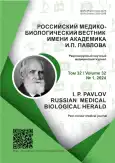Epidemiological and Epizootological Characteristics of Tick-Borne Viral Encephalitis and Tick-Borne Borreliosis in European Part of Russia
- Authors: Okunev N.D.1, Zdol'nik T.D.1
-
Affiliations:
- Ryazan Regional Clinical Hospital
- Issue: Vol 32, No 1 (2024)
- Pages: 73-80
- Section: Original study
- Submitted: 28.08.2023
- Accepted: 10.11.2023
- Published: 07.04.2024
- URL: https://journals.eco-vector.com/pavlovj/article/view/568883
- DOI: https://doi.org/10.17816/PAVLOVJ568883
- ID: 568883
Cite item
Abstract
INTRODUCTION: Tick-borne borreliosis (TBB) andtick-borne viral encephalitis (TBVE) are widely spread in the world and in Russia and have a high socioeconomic significance. The morbidity of the population with these infections is to a large extent determined by the epizootological situation formed in the natural conditions of certain natural climatic zones.
AIM: To obtain modern epidemiological and epizootological characteristics of TBB and TBVE in the territorial formations of the European part of Russia with different natural and climatic conditions.
MATERIALS AND METHODS: The work used the materials of the Governmental reports ‘On the state of sanitary and epidemiological welfare of the population’ of the territorial departments of Rospotrebnadzor in the European part of Russia in 2012–2021.
RESULTS: The maximum incidence of TBB and TBVE (5.00 and 1.83 per 100 thousand population) is characteristic of the territory of the Northwestern Federal District (NWFD) of Russia with the natural and climatic conditions of the taiga zone. The second and third positions are occupied by the Central (4.53 and 0.34 per 100 thousand) and the Volga (3.59 and 1.11 per 100 thousand) federal districts whose territories include several natural zones. In the Southern and North Caucasian federal districts where a significant part of the territory is located in the steppe and forest-steppe zone, the incidence of TBB is 0.63 and 0.16 per 100 thousand, respectively, the incidence of TBVE is practically not recorded. The incidence of TBB and TBVE in the population correlates with the proportion of people bitten by ticks — in the Northwestern Federal District the correlation coefficient was 0.89 and 0.74, in the Central Federal District — 0.65 and 0.68, in the Volga Federal District — 0.90 and 0.92. The ratio of infection of ticks removed from people in the Northwestern Federal District with agents of TBB and TBVE was 9.7:1.0. The total annual average area of acaricide treatments has a maximum value in the Central Federal District — 14333.6 hectares. In the territorial formations of the European part of Russia with the largest acaricide treatment area, an inverse correlation was found between this indicator and the proportion of people bitten by ticks (r = -0.40).
CONCLUSIONS: The epidemiological and epizootological characteristics of TBB and TBVE in 2012–2021 in the territorial formations of the European part of Russia indicate the influence of conditions of certain natural and climatic zonesof these territorieson the formation of epizootic foci and the incidence of these infections in the population, which should be taken into account when planning and implementing anti-epidemic measures.
Full Text
About the authors
Nikita D. Okunev
Ryazan Regional Clinical Hospital
Author for correspondence.
Email: OkunevND@yandex.ru
ORCID iD: 0000-0003-1412-1244
Russian Federation, Ryazan
Tat'yana D. Zdol'nik
Ryazan Regional Clinical Hospital
Email: zdolnikt@mail.ru
ORCID iD: 0000-0002-5721-2544
References
- Polishchuk MV, Zdol’nik TD, Smetanin VN. Ixodes tick-borne borrelioses: modern epidemiological situation in the center of the European part of Russia. I. P. Pavlov Russian Medical Biological Herald. 2017;25(2):202–8. (In Russ). doi: 10.23888/PAVLOVJ20172202-208
- Simakova AI. Ixodic tickborreliosis in Primorsky region. Pacific Medical Journal. 2005;(1):68–71. (In Russ).
- Lishchuk NG. Epidemiologiya i profilaktika iksodovogo kleshchevogo borrelioza. Regional’nyy Vestnik. 2019;(10):7. (In Russ).
- Zlobin VI. Kleshchevoy entsefalit v Rossiyskoy Federatsii: etiologiya, epidemiologiya i strategiya profilaktiki. Terra Medica Nova. 2010;(2): 13–21. (In Russ).
- Shirokostup SV, Lukyanenko NV, Saldan IP. Epidemiological analysis of the morbidability of tickling viral encephalitis of rural population of the Siberian federal district. Nauka Molodykh (Eruditio Juvenium). 2019;7(4):518–25. (In Russ). doi: 10.23888/HMJ201974518-525
- Pavlenko EV, Leonova GN, Maystrovskaya OS. Sravnitel’noye izucheniye immunogennosti vaktsin protiv kleshchevogo entsefalita.The Far Eastern Journal of Infectious Pathology. 2007;(11):56–62. (In Russ).
- Strnad M, Grubhoffer L, Rego ROM. Novel targets and strategies to combat borreliosis. Appl Microbiol Biotechnol. 2020;104(5):1915–25. doi: 10.1007/s00253-020-10375-8
- Utenkova EO, Savinykh NA. Tick-borne encephalitis in Russia and Europe (Review). Medical Almanac. 2021;(2):13–21. (In Russ).
- Hubálek Z. Epidemiology of Lyme borreliosis. Curr Probl Dermatol. 2009;37:31–50. doi: 10.1159/000213069
- Kuehn BM. CDC estimates 300 000 US cases of Lyme disease annually. JAMA. 2013;310(11):1110. doi: 10.1001/jama.2013.278331
- Lubova VA, Leonova GN. Ixodes tick-borne borreliosis (historical questions). Health. Medical Ecology. Science. 2016;(2):43–9. (In Russ). doi: 10.18411/hmes.d-2016-076
- Yasjukevich VV, Titkina SN, Popov IO, et al. Climate-dependant diseases and arthropod vectors: possible influence of climate change observed in Russia. Problemy Ekologicheskogo Monitoringa i Modelirovaniya Ekosistem. 2013;25:314–59. (In Russ).
- Oborin MS, Artamonova OA. The analysis of geographical spread regularities of tick-borne encephalitis and lyme borreliosis in the territory of Russia. Bulletin of Altai State Agricultural University. 2016;(1):87–92. (In Russ).
- Korenberg EI, Gorelova NB, Kovalevskiĭ YuV. Main features of natural focality of ixodid tick-borne borrelioses in Russia. Parazitologiia. 2002;36(3):177–91. (In Russ).
Supplementary files









